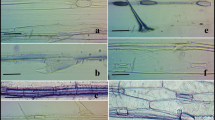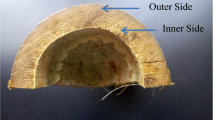Abstract
Pennisetum typhoides of the family Poaceae is one of the major cereal crop of India which accumulates silica in the form of phytoliths. Silica which forms phytoliths in the plants protects the plant from various biotic and abiotic stresses. Silica also offers durability stiffness and mechanical support to the leaves and stem. Present paper reveals the morphology, diversity, and frequency of opal phytoliths in the leaves, leaf sheaths, stems, and inflorescence of Pennisetum typhoides. A range of phytolith types are present in all parts of the plant, which are very characteristic and may be useful in the taxonomic identification of the plant. While other forms include the epidermal long cells, long micro hairs, parallelepipedal, prickle micro hairs, stomata, bulliform, trapezoids phytoliths, the most common one is the bilobate phytolith.




Similar content being viewed by others
References
Harvey EL, Fuller DQ (2005) Investigating crop processing using phytolith analysis: the example of rice and millets. J Arch Sci 32:739–752
Piperno DR (2006) Phytoliths: a comprehensive guide for archaeologists and paleoecologists. Rowman Altamira,
Mercader J, Astudillo F, Barkworth M, Bennett T, Esselmont C, Kinyanjui R, Dyan LG, Simpson S, Walde D (2010) Poaceae phytoliths from the Niassa Rift, Mozambique. J Arch Sci 37:1953–1967
Fahmy AG (2008) Diversity of lobate phytoliths in grass leaves from the Sahel region, West Tropical Africa: tribe Paniceae. Plant Syst Evol 270:1–23
Jarvis SC (1987) The uptake and transport of silicon by perennial ryegrass and wheat. Plant Soil 97:429–437
Chauhan DK, Tripathi DK, Rai NK, Rai AK (2011) Detection of biogenic silica in leaf blade, leaf sheath, and stem of bermuda grass (Cynodon dactylon) using LIBS and phytolith analysis. Food Biophys 6:416–423
Tripathi DK, Kumar R, Chauhan DK, Rai AK, Bicanic D (2011) Laser-induced breakdown spectroscopy for the study of the pattern of silicon deposition in leaves of saccharum species. Inst Sci Tech 39:510–521
Chauhan DK, Tripathi DK, Sinha P, Tiwari SP (2009) Biogenic silica in some pteridophytes. Biona 29:1–9
Pearsall DM (2000) Paleoethnobotany: a handbook of procedures, 2nd edn. Academic Press, San Diego, p 700
Clifford HT, Watson L (1977) Identifying grasses: data, methods and illustrations. University of Queensland Press, St. Lucia, p 146
Piperno DR, Pearsall DM (1998) The silica bodies of tropical American grasses: morphology, taxonomy, and implications for grasses systematic and fossil phytolith identification. Ann Smit Inst 85:1–40
Tripathi DK, Singh VP, Kumar D and Chauhan DK (2012) Rice seedlings under cadmium stress: effect of silicon on growth, cadmium uptake, oxidative stress, antioxidant capacity, and root and leaf structures. Chemistry and Ecology 28:281–291
Tripathi DK, Singh VP, Kumar D, Chauhan DK (2012) Impact of exogenous silicon addition on chromium uptake, growth, mineral elements, oxidative stress, antioxidant capacity, and leaf and root structures in rice seedlings exposed to hexavalent chromium. Acta Physiologiae Plantarum 34:279–289
Epstein E (1999) Silicon. Ann Rev Plant Phys Plant Mol Biol 50:641–664
Ma JF (2004) Role of silicon in enhancing the resistance of plants to biotic and a biotic stresses. Soil Sci Plant Nutr 50:11–18
Lu H, Liu Z, Wu N, Serge B, Yoshiki S, Liu B, Luo W (2002) Rice domestication and climatic change: phytolith evidence from East China. Bore 31:378–385
Mulholland SC (1989) Phytolith shape frequencies in North Dakota grasses: a comparison to general patterns. J Arch Sci 16:489–511
Rovner I (1971) Potential of opal phytolith for use in paleoecological reconstruction. Quart Res 1:343–359
Wang YJ, Lu HY (1993) The study of phytolith and its application. China Ocean Press, Beijing, pp 70–77 (in Chinese)
Metcalfe CR (1960) Anatomy of the Monocotyledons I. Gramineae. Oxford University Press, London
Twiss PC, Suess E, Smith RM (1969) Morphological classification of grass phytoliths. Soil Sci Soc Am Proc 33:109–115
Krishnan S, Samson NP, Ravichandran P, Narasimhan D, Dayanandan P (2000) Phytoliths of Indian grasses and their potential use in identification. Bota J Linn Soc 132:241–252
Chauhan DK, Tripathi DK, Kumar D, Kumar Y (2011) Diversity, distribution and frequency based attributes of phytolith in Arundo donax L. Int J Innov Biol Chem Sci 1:22–27
Acknowledgments
Authors are thankful to Head of the Botany Department, University of Allahabad, Allahabad, India for providing the necessary research facilities. Mr. Durgesh Kumar Tripathi is also grateful to the Allahabad University for providing D.Phil. Fellowship under the UGC scheme.
Author information
Authors and Affiliations
Corresponding author
Rights and permissions
About this article
Cite this article
Tripathi, D.K., Chauhan, D.K., Kumar, D. et al. Morphology, Diversity and Frequency Based Exploration of Phytoliths in Pennisetum typhoides Rich. Natl. Acad. Sci. Lett. 35, 285–289 (2012). https://doi.org/10.1007/s40009-012-0050-x
Received:
Accepted:
Published:
Issue Date:
DOI: https://doi.org/10.1007/s40009-012-0050-x




